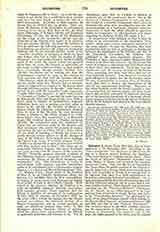

Sylvester I, Saint, POPE (314-335), date of birth unknown; d. December 31, 335. According to the “Libor pontificalis” (ed. Duchesne, I, 170) he was the son of a Roman named Rufinus; the legendary “Vita beati Sylvestri” calls his mother Justa. After the death of Miltiades (Melchiades) Sylvester was made Bishop of Rome, and occupied this position twenty-one years. This was the era of Constantine the Great, when the public position of the Church so greatly improved, a change which must certainly have been very noticeable at Rome; it is consequently to be regretted that there is so little authoritative information concerning Sylvester’s pontificate. At an early date legend brings him into close relationship with the first Christian emperor, but in a way that is contrary to historical fact. These legends were introduced especially into the “Vita beati Sylvestri” (Duchesne, loc. cit., Introd., cix sq.) which appeared in the East and has been preserved in Greek, Syriac, and Latin in the “Constitutum Sylvestri”—an apocryphal account of an alleged Roman council which belongs to the Symmachian forgeries and appeared between 501 and 508, and also in the “Donatio Constantini”. The accounts given in all these writings concerning the persecution of Sylvester, the healing and baptism of Constantine, the emperor’s gift to the pope, the rights granted to the latter, and the council of 275 bishops at Rome, are entirely legendary. The pope, however, took part in the negotiations concerning Arianism and the Council of Nica, and the expression Greek: omoousios was probably agreed upon with him before the council. The pontiff also sent legates to the first ecumenical council. Still it is not certain whether Constantine had arranged beforehand with Sylvester concerning the actual convening of the council, nor whether there was an express papal confirmation of the decrees beyond the signatures of the papal legates (cf. Funk in “Kirchengesch. Abhandlungen and Untersuchungen”, I, 95, 501 sq.).
During Sylvester’s pontificate were built the great churches founded at Rome by Constantine, e.g. the basilica and baptistery of the Lateran near the former imperial palace where the pope lived, the basilica of the Sessorian palace (Santa Croce), the Church of St. Peter in the Vatican, and several cemeterial churches over the graves of martyrs. No doubt the pope helped towards the construction of these churches. Sylvester’s memory is especially connected with the titular Church of Equitius, which takes its name from a Roman presbyter who is said to have erected this church on his property. It was situated near the thermce of Diocletian, and still exists. Parts of the present building may date from the fourth century. No doubt the pope contributed to the development of the liturgy of the Church at Rome. During his reign, moreover, the first martyrology of Roman martyrs was probably drawn up. Sylvester is connected also with the establishment of the Roman school of singing. On the Via Salaria he built a cemeterial church over the Catacomb of Priscilla, the ruins of which have lately been brought to light. In this church he was buried. His feast is given under December 31 in the “Depositio episcoporum”, or list of the burial days of the Roman bishops, which was compiled barely a year after his death; the same date is given in the “Calendar” of Philocalus. This day, therefore, is doubtless the day of his burial. For his possible relations with Armenia, see Gregory the Illuminator, Saint.
J. P. KIRSCH

